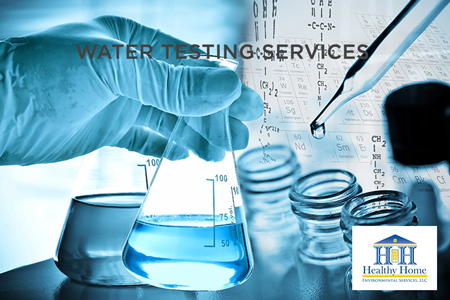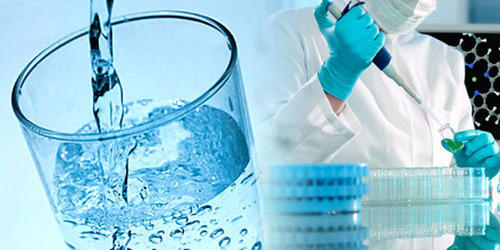Discover Reliable Well Water Testing Services for Your Comfort
Wiki Article
Discover What Is Consisted Of in Water Evaluating and Just How It Makes Certain Safe Drinking Water
Comprehending the ins and outs of water testing is essential in guaranteeing the quality and safety and security of our alcohol consumption water. Through a precise assessment of physical, chemical, and microbiological elements, water testing recognizes prospective pollutants that could pose health and wellness dangers. From the existence of heavy steels to damaging microorganisms, each test element plays a crucial duty in keeping the stability of our water supply. Advanced techniques like chromatography and spectrometry enhance the accuracy of these analyses. How do these procedures equate into the regulatory structures that ensure safety in our day-to-day intake?Trick Elements of Water Screening
Water testing is an important process that involves several crucial parts to make sure the safety and quality of drinking water. In addition, making certain the pH balance of water is crucial, as it influences the water's corrosiveness and the efficiency of sanitation procedures.One more significant component entails microbiological analysis, where water samples are checked out for the existence of microbes such as bacteria, viruses, and protozoa. If consumed, this analysis is vital to recognize organic dangers that could present health risks. In addition, chemical evaluations are performed to detect inorganic and organic substances, such as heavy metals, nitrates, and pesticides, that might be existing in the water supply.

Detecting Damaging Impurities
Detecting unsafe pollutants in alcohol consumption water is an essential element of protecting public health. Each type of contaminant positions distinctive health risks, making their discovery essential to ensure the water consumed by the public is risk-free.
Water screening for impurities is commonly performed by governing agencies and water utilities, employing a mix of area tasting and lab analysis. These assessments are designed to detect both normally occurring substances and anthropogenic contaminants that may have entered the supply of water through agricultural runoff, industrial discharge, or maturing facilities. Routine surveillance is crucial, as contamination levels can vary due to environmental modifications, seasonal variants, or human tasks.
The identification of hazardous impurities educates essential actions, such as water therapy interventions or public advisories, to alleviate risks. Early discovery is crucial to avoid adverse health results, varying from gastrointestinal diseases to lasting conditions like cancer cells, consequently making certain the proceeded security of drinking water.

Chemical Evaluation Methods
In the world of making sure risk-free drinking water, chemical evaluation methods play a pivotal role in determining and evaluating pollutants. These methods are necessary for detecting a vast selection of chemical substances, consisting of heavy steels, chemicals, and commercial toxins, which can posture substantial health threats. Techniques such as atomic absorption spectroscopy (AAS) and inductively coupled plasma mass spectrometry (ICP-MS) are typically employed to measure trace degrees of steels like arsenic, mercury, and lead. These instruments give precise metrology, helping with compliance with regulatory standards.Gas chromatography-mass spectrometry (GC-MS) is an additional critical method, especially for natural compounds. It separates complex blends and recognizes unstable and semi-volatile natural compounds, making sure that contaminants like benzene and toluene are within secure restrictions. High-performance fluid chromatography (HPLC) is in a similar way made use of for non-volatile compounds, including particular chemicals and pharmaceuticals.
Ion chromatography is employed to determine focus of cations and anions, such as nitrates and sulfates, which are essential in analyzing water high quality. These chemical evaluation methods collectively guarantee that drinking water stays safe by detecting deviations from developed pureness norms, thus guarding public wellness. Making certain accuracy and precision in these examinations is paramount to maintaining the honesty of water security assessments.
Microbiological Evaluating Approaches
Exact microbiological testing is important for securing public wellness by making sure that alcohol consumption water is cost-free from dangerous virus. This process involves detecting and identifying bacteria such as germs, infections, and protozoa that may contaminate water supplies. Common microorganisms consist of Escherichia coli, Giardia, and Cryptosporidium, each posturing considerable health risks.Several approaches are employed in microbiological testing to recognize these risks. The membrane purification technique is frequently utilized, involving water going through a filter that catches bacteria, which are after that cultured to identify their visibility and focus. The multiple-tube fermentation technique makes it possible for the metrology of coliform bacteria utilizing a series of dilution and incubation steps.
Improvements in modern technology have presented molecular methods such as polymerase chain response (PCR), which allows for the very specific and fast detection of pathogens by magnifying their hereditary product. Enzyme-linked immunosorbent assays (ELISA) also use an approach to detect virus by recognizing certain healthy proteins or antigens.
These varied methods are necessary for detailed water high quality evaluation, making certain that water treatment procedures are reliable and that distribution systems maintain safety. By employing these microbiological testing methods, Get More Information prospective wellness hazards can be identified and mitigated promptly.

Relevance for Public Wellness
Making certain the microbiological security of drinking water directly impacts public wellness by avoiding the spread of waterborne conditions. Microorganisms such as bacteria, viruses, and protozoa can lead to illnesses like cholera, dysentery, and stomach infections (Water Testing Service). The implementation of extensive water testing methods is paramount in recognizing and reducing these dangers, hence securing communities from possible outbreaksNormal water testing not just identifies microbial pollutants but likewise assesses chemical and physical specifications that can impact wellness. Too much levels of nitrates or heavy steels such as lead can pose significant health dangers, specifically to susceptible populaces like babies and pregnant more helpful hints women. By recognizing these hazards early, water testing allows prompt interventions, guaranteeing the water remains within safe usage criteria.
Moreover, water testing plays a critical role in maintaining public confidence in local water supply. It provides transparency and accountability, assuring the general public that their wellness is a top priority. For plan manufacturers and health officials, the data originated from water screening notifies choices on framework financial investments and public wellness methods, making certain sources are routed where they are most needed. This way, water testing is essential in promoting a much healthier, safer society.
Verdict
Water screening serves as a vital mechanism for ensuring the safety and security and high quality of drinking water through comprehensive evaluation of its physical, chemical, and microbiological properties. By spotting dangerous contaminants, such as heavy metals and chemicals, and utilizing advanced strategies like chromatography and spectrometry, water screening promotes the identification of potential health and wellness dangers. The application of extensive screening methods is crucial for preserving conformity with safety standards, inevitably safeguarding public health and wellness and strengthening confidence in metropolitan water supply.
By determining these hazards early, water screening allows timely interventions, making certain the water supply remains within risk-free consumption requirements.
Water screening offers as a vital device for making certain the safety and quality of drinking water through comprehensive examination of its physical, chemical, and microbiological buildings.
Report this wiki page